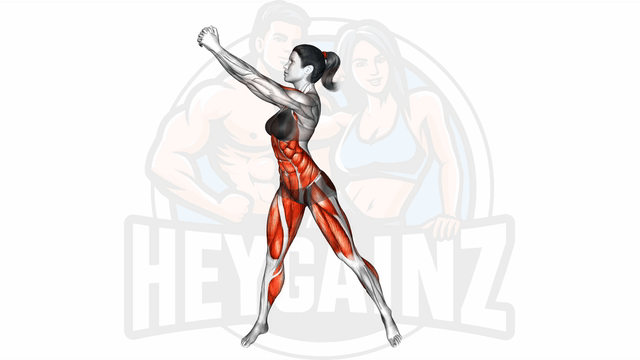
Instructions:
- 1Stand with your feet hip-width apart
- 2Perform a typical squat lower with your hips back and down
- 3When you stand back up, lift one leg out to the side before placing it back on the ground
- 4Switch sides and repeat
Tips:
- Keep your chest up and back straight during the exercise
- Ensure your knees don't go over your toes during squat
- Engage your core to help maintain balance
- Keep your lifted foot flexed and heel down
Understanding the Side-up Squat
The side-up squat, also commonly referred to as the side step up squat, is an effective bodyweight exercise that focuses on enhancing your strength and stability, particularly in the lower body. This plyometric movement is designed to engage multiple muscle groups, making it an excellent addition to any fitness routine, whether you're a beginner or an experienced athlete.
Muscle Engagement
When performing side-up squats, you primarily target the muscles in your legs, including the quadriceps, glutes, and hamstrings. Additionally, this exercise works the muscles in your core, helping to improve overall body strength and stability. By incorporating side squats into your regimen, you'll not only build strength but also improve your balance and coordination.
Correct Position for Squats
To achieve the correct position for side squats, begin by standing with your feet shoulder-width apart. Step sideways with one foot while lowering your hips into a squat position. Keep your back straight and chest up to maintain proper form. Ensure that your knees do not extend past your toes, as this can lead to unnecessary strain.
Benefits of Side Squats
- Improves lower body strength
- Enhances balance and coordination
- Increases flexibility in the hips
- Helps prevent injuries by strengthening stabilizing muscles
Tips for Effective Practice
To maximize the effectiveness of your side-up squats, consider the following tips:
- Engage your core: Keep your abdominal muscles tight to support your lower back.
- Control your movement: Ensure that you perform the exercise slowly and with control to maintain balance and prevent injury.
- Incorporate variations: Experiment with different squat depths or add short jumps to increase the intensity of your workout.
Incorporating the side-up squat into your fitness routine can lead to improved strength, stability, and overall lower body fitness. Whether you’re looking to build muscle, enhance performance, or simply stay active, this versatile exercise is a great choice.